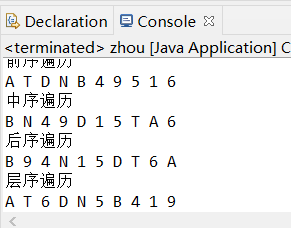软件工程作业04
| 这个作业属于哪个课程 | https://edu.cnblogs.com/campus/zswxy/2018SE | |
|---|---|---|
| 这个作业要求在哪里 | https://edu.cnblogs.com/campus/zswxy/2018SE/homework/11406 | |
| 这个作业的目标 | 知道什么是算法,会用算法 | |
| 其他参考文献 | 博客园,CSDN,简书 |
1.题目名称:用排序算法找数组中第K大的数
解题思路:A[1001]存储n个数据,Temp[1001]存储A[ ]中第 l 个到第 r 个的数据,然后对Temp进行sort排序,
最后找出从小到大的第(length+1-k)的数据(就是从大到小的第k个数据)
解题代码
package puyuexing;
import java.util.Arrays;
import java.util.Scanner;
public class pu {
public static void main(String[] args) {
// TODO Auto-generated method stub
Scanner sc = new Scanner(System.in);
// 定义序列长度
int n = sc.nextInt();
// 定义序列
int[] a = new int[n];
// 依次输入序列
for (int i = 0; i < n; i++) {
a[i] = sc.nextInt();
}
// 定义询问s个数
int s = sc.nextInt();
// 每行有三个数
int[][] arr = new int[s][3];
// 输入的三个数
for (int i = 0; i < s; i++) {
// 第s行第1个数
arr[i][0] = sc.nextInt();
arr[i][1] = sc.nextInt();
arr[i][2] = sc.nextInt();
}
sc.close();//关闭输入资源
for (int i = 0; i < s; i++) {
System.out.println(getMaxk(a, arr[i][0], arr[i][1], arr[i][2]));
}
}
public static int getMaxk(int[] a, int begin, int end, int k) {
int aa[] = new int[end - begin + 1];// 创建一个数组,长度为end
// 用来装表示的开始到结束的数组,第几个到第几个,谁最大
for (int i = 0; i < aa.length; i++) {
aa[i] = a[begin + i - 1];
}
Arrays.sort(aa);// 进行排序,从小到大
return aa[aa.length - k];// 第几大
}
}
执行结果

2.题目名称:二叉树的先、中、后 序遍历与层级遍历
解题思路:对于树的遍历:
有递归实现
非递归实现(借助于栈,后进先出)
参差遍历 (借助队列)
解题代码
package puyuexing;
import java.util.LinkedList;
public class zhou {
public static void main(String[] args) {
/*
作业要求:叉树的先、中、后 序遍历与层级遍历
自己实现四个方法,main方法中调用,将结果打印到控制台
*/
/* 二叉树的结构
A
/ \
T 6
/
D
/ \
N 5
/ \ /
B 4 1
\
9
*/
Node root = into();
// 先序遍历
System.out.println("\n"+"前序遍历");
A(root);
// 中序遍历
System.out.println("\n"+"中序遍历");
B(root);
// 后续遍历
System.out.println("\n"+"后序遍历");
C(root);
// 层级遍历
System.out.println("\n"+"层序遍历");
D(root);
}
private static void A(Node root) {
// TODO 先序遍历
if (root == null) return;
System.out.print(root.data +" ");
A(root.l);
A(root.r);
}
private static void B(Node root) {
// TODO 中序遍历
if (root == null) return;
B(root.l);
System.out.print(root.data+" ");
B(root.r);
}
private static void C(Node root) {
// TODO 后续遍历
if (root == null) return;
C(root.l);
C(root.r);
System.out.print(root.data +" ");
}
private static void D(Node root) {
// TODO 层级遍历
LinkedList list= new LinkedList<>();
list.add(root);
while(! list.isEmpty()) {
Node ww=(Node) list.pop();
if(ww.l !=null) {
list.offer(ww.l);
}
if(ww.r !=null) {
list.offer(ww.r);
}
System.out.print(ww.data +" ");
}
}
// 构建一颗树,返回根节点
private static Node into(){
Node root = new Node("A");
Node node1 = new Node("T");
Node node2 = new Node("D");
Node node3 = new Node("N");
Node node4 = new Node("B");
Node node5 = new Node("6");
Node node6 = new Node("5");
Node node7 = new Node("4");
Node node8 = new Node("9");
Node node9 = new Node("1");
root.l = node1;
node1.l = node2;
node2.l = node3;
node2.r = node6;
node3.r = node7;
node7.r = node8;
node6.l = node9;
node3.l = node4;
root.r = node5;
return root;
}
// 节点
static class Node{
// 数据
Object data;
// 左孩子
Node l;
// 右孩子
Node r;
public Node(){}
public Node(Object data) {
this.data = data;
this.l = null;
this.r = null;
}
public Node(Object data, Node l, Node r) {
this.data = data;
this.l = l;
this.r = r;
}
}
}



